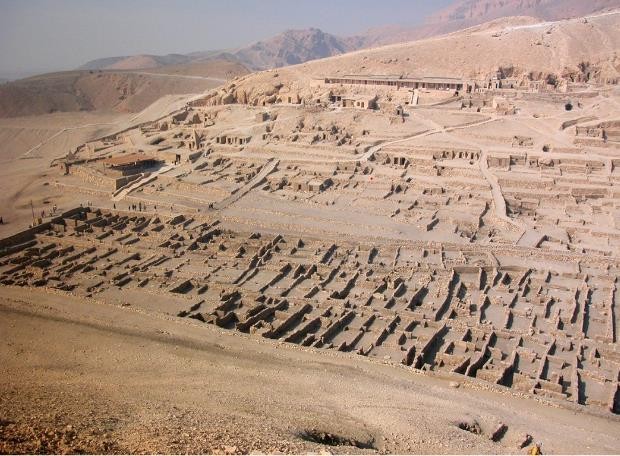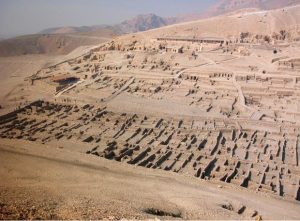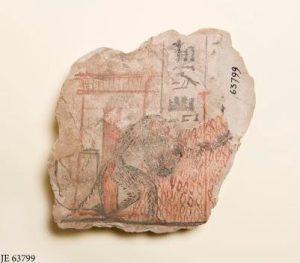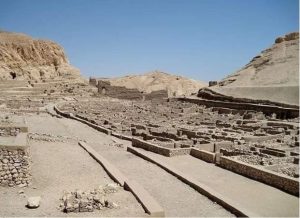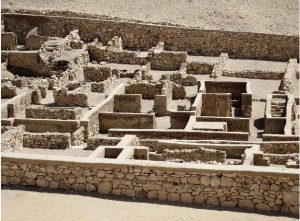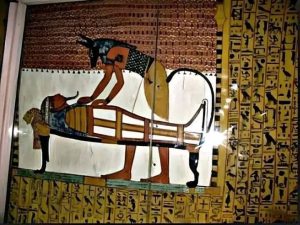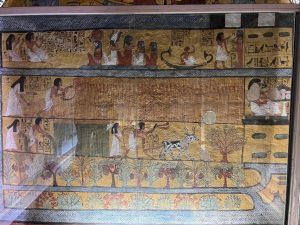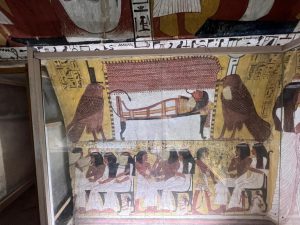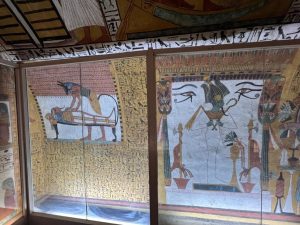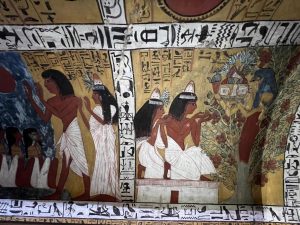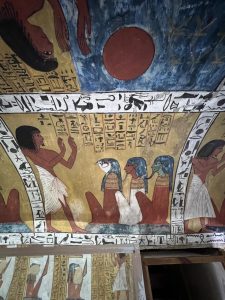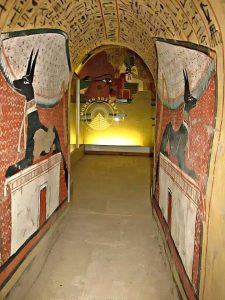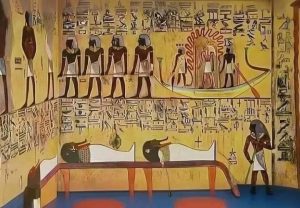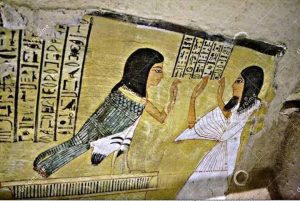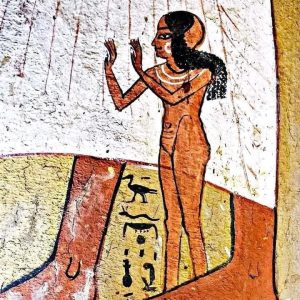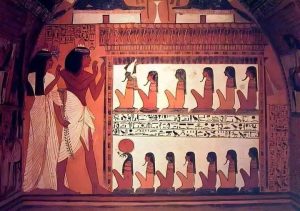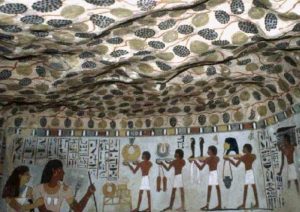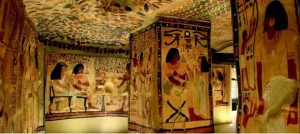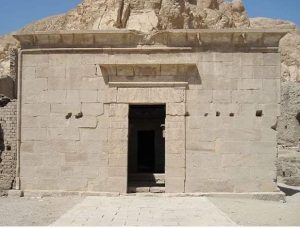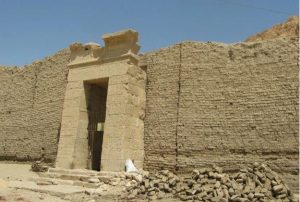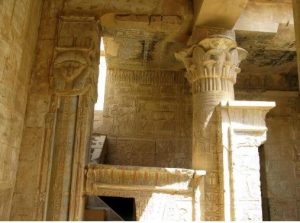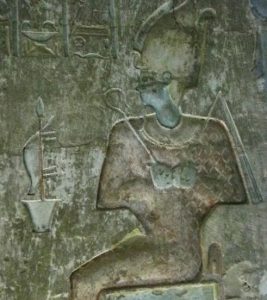Deir el-Medina
Deir means a place of worship in the Christian religion. Deir el-Medina is part of the Theban Necropolis, located north of the Valley of the Kings. It was named Deir el-Medina due to the existence of a Christian monastery in that area from the 6th century AD. The word “el-Medina” means “the city” because there was a complete city for the workers who worked in the tombs and temples of Western Thebes. It was a headquarters for the workers and artisans during the New Kingdom from 1570 to 1070 BC. These workers were divided into two parts: a part specialized in building and digging tombs, and another part consisting of artists who made statues, furniture, and vessels. Because the ancient Egyptians believed that the pharaoh will live in heaven among the gods after his death, with the possibility of visiting the earth and his family after his death, and even helping them. Therefore, every worker in Deir el-Medina worked diligently because he believed that the pharaoh would take care of him from heaven.
Buildings of Deir el-Medina: The entrance consisted of two pylons leading to a courtyard. At the end of the courtyard was a chamber in the form of a vaulted ceiling. The chamber usually consisted of one room, and above it was a small pyramid made of limestone. However, now most of the tombs have lost their upper part, and only the lower part remains. The remains of the workers’ houses in Deir el-Medina show that they were a distinguished class. They lived in houses, cooked food, raised children, and lived in a state of luxury. Some of them built a tomb for themselves and their wives. In the Deir el-Medina area, the remains of a well were found, indicating that it was used in ancient times. And the most beautiful thing about it is that it is like the idea of modern mailboxes, as they used to throw shards of pottery into it, written with messages and drawings. It is considered a library about their daily lives in the past. We find in it some love letters, complaints, and prayers.
general view for Deir el-Medina area
One of the shards discovered in Deir el-Medina and preserved in the Egyptian Museum in Tahrir
The strike of the workers of Deir el-Medina
At the end of the New Kingdom, especially after the death of the great kings like Ramesses II, the workers began to not receive their wages on time. So, in the year 1170, during the reign of King Ramesses III, they carried out the first workers’ strike in history. They wrote a complaint to the vizier and refused to return to work until their demands were met. When their demands were met, they returned to their work
Planning of the workers’ city in Deir el-Medina
workers’ homes in Deir el-Medina
workers’ homes in Deir el-Medina
Tomb Robberies
After the reign of Ramesses IV (around 1155 to 1149 BC), the problems of famine and food shortages did not end. This led to the formation of groups of unemployed workers who resorted to robbing the tombs of pharaohs and their treasures. They would dig side tunnels, away from the guards, until they reached the chambers filled with precious jewelry and gold. Some overseers were also involved, receiving bribes in return. There are manuscripts that describe what the authorities did with these gangs. They would interrogate the perpetrators under torture to reveal all the participants in the tomb robberies. The punishments were severe. However, the stolen goods were not returned to the tomb from which they were taken. Instead, the court would add them to its own treasures. A papyrus from the reign of Ramesses IX, belonging to the 20th dynasty, speaks about tomb robberies and states, “There was a dispute between the governor of eastern Thebes and the governor of western Thebes regarding the issue of tomb robberies. The governor of the east accused the governor of the west of aiding these gangs by protecting them.” Investigations proved the governor of the east’s claims to be correct, and the governor of the west was dismissed.
The Discovery of Deir el-Medina
The French scholar, Gaston Maspero, removed the sand from the ruins of the Deir el-Medina area in February 1886. This discovery revealed to us many features of Deir el-Medina. The most beautiful thing found was the tomb of ” Sennedjem,” which dates back to the 19th dynasty and is numbered TT1. Then, in 1906, Bartolomeo, the director of the Turin mission in Egypt, discovered the beautiful tomb of a man named “Kha.”
The Tomb of Sennedjem (Tomb Number TT1)
The tomb of Sennedjem is considered the most beautiful tomb in Deir el- Medina. Sennedjem was an overseer of the workers in the city of Deir el- Medina and oversaw the construction of the tombs of Seti I and Ramesses II. When the tomb was discovered, it was found completely intact and had not been robbed since the time of the pharaohs until its discovery. All its contents were subsequently transferred to the British Museum.
Description of the Tomb
The burial chamber is a room with a vaulted ceiling. It contains very beautiful scenes, the most important scenes:
• god Anubis over the mummy of the deceased, indicating the mummification process. Also, the deceased’s bed takes the form of a lion.
• Scenes of the Iaru fields, which represent heaven in ancient Egypt.
• Scenes of the deceased and his wife worshipping ten of gatekeepers, each separated by a scepter in his hand.
• A scene of the deceased’s followers holding stalks of papyrus.
• Scenes of the deceased worshipping various gods.
• As for the ceiling of the chamber, there are 8 scenes divided into two rows, in each of which Sennedjem is worshipping different gods and the sacred tree.
The scene of Anubis performing the mummification process for the deceased, and we see the deceased’s bed in the form of a lion.
The scene of Sennedjem and his wife harvesting wheat.
The scene of the deceased’s mummy, with Isis and Nephthys beside her.The scene of the deceased’s mummy, with Isis and Nephthys beside her.
On the right, Anubis is mummifying the deceased, and on the left, the god Osiris is inside his shrine.
The scene of Sennedjem and his wife in front of the sacred tree.
The scene of Sennedjem worshipping the god Horus.
The Tomb of “kha” (TT8):
It was built by “kha” for himself and his wife. When it was discovered by the Italian researcher, “Bartelli,” in 1906, it was full of contents and golden ornaments. It was transported to Turin where it is displayed in a museum there and is designated with the symbol TT8.
The Tomb of Bashidu (TT298):
This tomb is distinguished by the fact that it has preserved its scenes with their full colors until now.
Description of the Tomb:
A descending staircase leads to several chambers and corridors, including a small waiting room and then a burial chamber with a vaulted ceiling. The tomb is decorated with eye-catching inscriptions and colors. One of the most beautiful scenes in the burial chamber shows Bashidu kneeling beside a palm tree on the edge of a pond. Some interpret this scene as him drinking from the pond’s water, while others interpret it as him praying. There are also scenes of Bashidu and his relatives worshipping various gods. There is a scene of Bashidu, his wife, and two small children worshipping the god Horus. There is also a scene of the god Anubis, the god of mummification and guardian of the necropolis, sitting on his shrine. There is a beautiful inscription of Bashidu’s daughter and his wife on a pilgrimage boat sailing to Abydos. another wonderful scene of Bashidu worshipping the god Ptah-Sokar, the god of death and resurrection. There are inscriptions on the ceiling of the chamber of about 16 Egyptian deities. There are texts from the Book of the Dead to help the deceased in the afterlife.
A picture of the god Anubis inside the tomb of Bashidu
We see from above the scenes of the pilgrimage to Abydos and from below we see the mummy of the deceased.
We see on the right side of the picture Bashidu prostrating himself over a pond, it seems he is in a position of worship, and next to him is a very beautiful scene of fruit-bearing trees.
We see a wonderful scene of Bashidu in the form of a Ba bird, in front of him his wife is praying for him
Bashidu ‘s daughter stands at her father’s feet.
Bashidu and his wife are worshipping two groups of gods, the first led by Amun-Ra and the second led by Ra-Horakhty.
The Tomb of Sennefer (The Grapes Tomb):
He worked as an overseer of the gardens of the temple of Amun during the reign of King Amenhotep II, and he also worked during the reign of King Thutmose III and held the title of the King’s Seal Bearer. This tomb is unique compared to all the other tombs in West Thebes because its ceiling was not painted with inscriptions, but rather with grapes. We can even see the green and black colors of the grapes on the ceiling of the tomb.
We see on the ceiling of the tomb drawings of grapes.
We see Sennefer in front of an offering table.
Important scenes in the tomb:
A scene of Sennefer ‘s son wearing a leopard skin, performing purification and offering incense in front of an offering table behind which his parents sit. On the eastern wall, we see a priest wearing a leopard skin, sprinkling purification water on both Sennefer and his wife. An unusual scene shows Sennefer’s wife offering sacrifices to him. However, it is customary for sacrifices to be offered to the gods, not to the dead.
The Temple of Hathor in Deir el-Medina:
n the northern part of the city, there is a small temple of the goddess Hathor from the Ptolemaic era. The Copts of Egypt used it as a church during the Byzantine era, and that is why the area is called Deir el-Medina. There are also remains of other small temples, including a temple built by King Amenhotep I, a temple built by King Seti I, and a temple built by Ramses II. To the north of the temple, about 200 meters away, there is the dry well from which pottery shards were extracted. The Egyptians used these shards to write letters to their relatives, and they wrote accounts, plans, and drawings on them. This has helped us understand how the workers lived and how they adapted.
Image of the Temple of Hathor from the outside
The Temple of Hathor and a mud-brick wall surrounding it.
Inscriptions on ceiling of the Temple of Hathor, and we notice a Greek influence on the capitals of the columns.
Inscriptions on ceiling of the Temple of the Temple of Hathor, and we notice a Greek influence on the capitals of the
columns. An inscription of the god Osiris from inside his private chamber in the Temple of Hathor.

